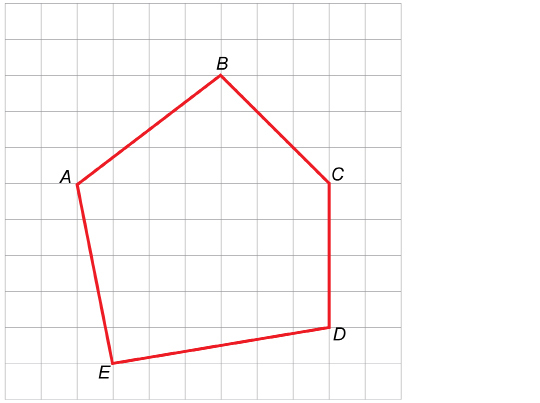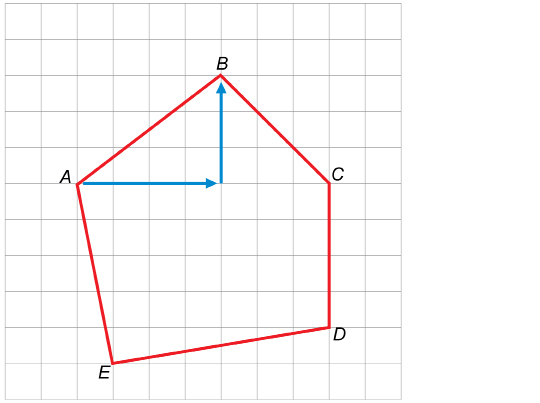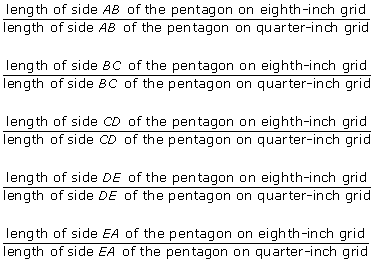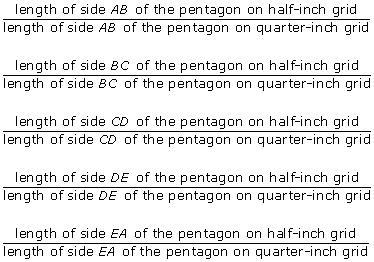Module 6
1. Module 6
1.3. Page 3
Module 6: Triangles and Other Polygons
Explore
You have just drawn geometrically similar cartoon figures or geometrically similar designs. In the past, you have also probably made enlargements and reductions on your computer screen by using the zoom control in a web browser, a drawing program, or other programs.
Sometimes size is selected automatically, as when you see this message on your screen: “This computer game has been adjusted to fit your screen.”
When zooming in or out from one size to another on your screen, an original figure and its enlargement are geometrically similar. It does not matter how complicated the figure is.
Polygons are not very complicated compared to some images you come across on your computer screen. So, to draw polygons, you can still use the grid technique you used at the beginning of this lesson. By drawing similar polygons, you can explore these questions:
-
What relationships exist among the sides of similar polygons?
-
What relationships exist among the angles of similar polygons?
 Try This
Try This
In this activity you will draw similar polygons on grid paper, and you will compare their characteristics.
Step 1: Draw a pentagon—a five-sided polygon—on quarter-inch grid paper. One possibility is given. Label the vertices A, B, C, D, and E going clockwise around the pentagon.

Step 2: Draw a similar pentagon on eighth-inch grid paper. For instance, for the given pentagon, start at point A. Then move four squares to the right and three squares up to locate B (shown on the previous grid). Then go three squares to the right and three squares down to C, and so on.

Step 3: Draw a similar pentagon on half-inch grid paper. Again, for the sample pentagon, start at point A. Then move four squares to the right and three squares up to locate B. Then go three squares to the right and three squares down to C, and so on.

Step 4: Measure the angles of each pentagon. Record these measures on each diagram.
Step 5: Measure, to the nearest millimetre, the sides of each pentagon. Record these lengths on each diagram.
Answer the following questions.
TT 1. How do the corresponding angles of the three pentagons compare?
TT 2. Find the following ratios for each pair of corresponding sides. Express your answers to one decimal place.

TT 3. Find the following ratios for each pair of corresponding sides. Arrows are drawn showing that vertex B is four squares to the right and three squares above vertex A. Divide to one decimal place.

TT 4. What do you notice about the ratios in TT 2? Think about the squares on the two grids. Why did you get the ratios you did in TT 2?
TT 5. What do you notice about the ratios in TT 3? Think about the squares on the two grids. Why did you get the ratios you did in TT 3?
 Share
Share
Use the discussion area for your class, or another method indicated by your teacher, to post your answers to TT 1 to TT 5, and to view the work of the people you are sharing with. Compare the answers for TT 1 to TT 5. Identify where you have similar answers and where your answers are different. Discuss all differences between your answers until you have agreement. If necessary, you may wish to involve your teacher in your discussion.
Summarize what you learned from these Try This and Share sections by forming two general statements as follows:
-
one statement to describe the corresponding angles of enlarged/reduced similar polygons
-
one statement to describe the ratios of corresponding sides of enlarged/reduced similar polygons
Save these statements and your grid diagrams in your course folder.